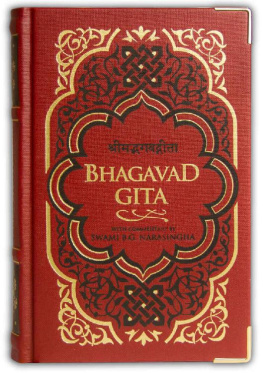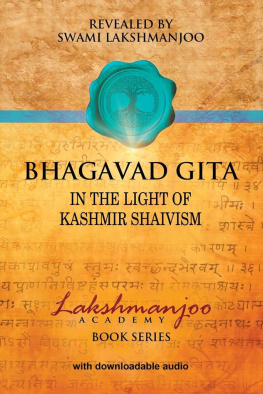Swami Chidbhavananda - The Bhagavad Gita
Here you can read online Swami Chidbhavananda - The Bhagavad Gita full text of the book (entire story) in english for free. Download pdf and epub, get meaning, cover and reviews about this ebook. year: 2020, publisher: Sri Ramakrishna Tapovanam, genre: Religion. Description of the work, (preface) as well as reviews are available. Best literature library LitArk.com created for fans of good reading and offers a wide selection of genres:
Romance novel
Science fiction
Adventure
Detective
Science
History
Home and family
Prose
Art
Politics
Computer
Non-fiction
Religion
Business
Children
Humor
Choose a favorite category and find really read worthwhile books. Enjoy immersion in the world of imagination, feel the emotions of the characters or learn something new for yourself, make an fascinating discovery.
- Book:The Bhagavad Gita
- Author:
- Publisher:Sri Ramakrishna Tapovanam
- Genre:
- Year:2020
- Rating:3 / 5
- Favourites:Add to favourites
- Your mark:
- 60
- 1
- 2
- 3
- 4
- 5
The Bhagavad Gita: summary, description and annotation
We offer to read an annotation, description, summary or preface (depends on what the author of the book "The Bhagavad Gita" wrote himself). If you haven't found the necessary information about the book — write in the comments, we will try to find it.
The Bhagavad Gita — read online for free the complete book (whole text) full work
Below is the text of the book, divided by pages. System saving the place of the last page read, allows you to conveniently read the book "The Bhagavad Gita" online for free, without having to search again every time where you left off. Put a bookmark, and you can go to the page where you finished reading at any time.
Font size:
Interval:
Bookmark:
Title page
The Bhagavad Gita
Original Stanzas - split up Reading - Transliteration Word for Word Translation - a Lucid English Rendering and Commentary.

By
SRIMATH SWAMI CHIDBHAVANANDA
SRI RAMAKRISHNA TAPOVANAM
TIRUPPARAITHURAI-639115
TIRUCHIRAPPALLI DT.
2020
Copyright
Tapovanam Series
Published by
The Secretary
Sri Ramakrishna Tapovanam
Tirupparaitturai
ISBN-81-8085-147-8
ALL RIGHTS RESERVED
Nominal Price . 240
Tapovanam Printing School, Tirupparaitturai - 639115
Typeset & eBook created by
Integra Software Services Private Limited, Pondicherry.
Contents
The PUBLISHERS NOTE
THE PUBLISHERS NOTE
The Tamil version of this book was first published in 1951. Since then it continues to be increasingly popular among the Tamil - knowing public. The Twenty Ninth edition of 10,000 copies is now on sale.
A request came to the author from several quarters that his Tamil commentary on the Bhagavad Gita might also be rendered into English for the benefit of the larger non - Tamil - knowing public. He has responded to the request and this has enabled us to bring out this English version. So far 1,92,000 copies have been sold. Twenty eighth impression of this book is in progress. Also we have brought out this commentary in Telugu & Oriya languages also and they are now on sale. In order to cater for an extensive demand in India, we have chosen to sell it at a nominal price much less than the actual cost. Three impressions of 10,000 copies each were sold at Rs. 6-00. Due to the increase of the price of paper, the price of the succeeding impressions were raised to Rs.7/-, Rs.7.50/-, Rs.9/-, Rs.12/-, Rs.15/-, Rs.20/-, Rs.24/-, Rs.30/-, Rs.42/-, Rs.50/-, Rs.60/-, Rs.75/-, Rs.100/-, Rs.105/-, Rs.115/- and Rs.125/- respectively. Owing to steady increase in the price of the printing materials we are now constrained to sell our Twenty Seventh Impression of this book at Rs. 240/- per copy.
Those who have missionary zeal for spreading the message of the Gita, are invited to co-operate with us in this holy service.
THE MYSTIC NUMBER EIGHTEEN
Numbers 18, 108, 1008, 10008 are all multiples of 9 which is a mystic number. All multiples of 9 added together ultimately become number 9. This can be verified (169=144; 1+4+4=9).
The mystic number 9 is arrived at thiswise:
The universe is constituted of the three factors-time, space and causation.
The universe is constituted of the three Gunas (ingredients)sattva, rajas and tamas.
The universe is constituted of the three functionscreation, preservation and destruction.
Thus this three times three making nine has become a mystic number. It exhausts the definition of the phenomenal universe.
Twice nine or eighteen makes the Mahabharata scheme complete.
The eighteen portions (Parvas) in the epic define in detail the career of man on earth.
The eighteen chapters in the Gita make yoga philosophy complete.
The eighteen days warfare makes the warriors exploits complete.
Eighteen are the divisions of the armies of the contending partiesPandavas and Kauravas. The one having seven divisions and the other eleven. Thus all the available human forces mobilized were eighteen in number.
The Mahabharata is thus an exposition of the human possibilities and achievements graded into eighteen, the first multiple of nine, a mystic number. The higher multiples of it signify further ranging into divine regions.
INTRODUCTION
INTRODUCTION
The Scriptural TrinityEnshrined in the MahabharataGods grace versus earthly powerLife beset with problemsAllegory Life and Message InseparableSages Nara and Narayana Intended for People of Arjunas typeWhy preached on the Battle-field?Who recorded?Gospel of slaughterBook of dissension and disruptionChange-over from the Pleasant to the GoodThe Bhagavad Gita UpanishadBrahma VidyaYoga Sastra Method of TeachingSruti and SmritiExposition of the Sentence SublimeCommentariesThe Best among the Commentaries Classification of the commentariesVedantaThe way of Sri KrishnaDefinition of GodThe Scripture Universal.
The Scriptural Trinity
The Scriptural Tri n ity
Scriptures are indispensable to all religions. They save religions from mutation and from e x tinction. That faith which has no gospel for its guidance gets lost in a series of transformations. Finally it disintegrates and loses its individuality. But a faith that draws sanction and inspiration from a sacred book is able to hold its own. It has in such a holy document authoritative statements to encounter the opposition and meet the attacks of the heterodox. All the religions of the world that have endured the ravages of time and of transformation have their own scriptures for anchorage. That the Bible is the scripture of the Christians is well known even to those beyond the pale of the Christendom. The Quraan remains ever associated with the followers of the Islamic religion. The scripture of the Buddhist is the sacred collection of all the enlightened utterances of the Buddha, known as the Dammapada. The followers of all the other important religions may also be said to be more familiar with their sacred books than with their kith and kin. But the case of the Hindu is different. Among the followers of different paths, he alone is bewildered in regard to this question. He does not know which book he may term his scripture. If a mention is made of the Vedas he confesses he has never had occasion to see or handle such books as these, let alone the question of getting acquainted with their contents. Many a Hindu, may mention with some hesitance this or that as the sacred book from which he draws inspiration and guidance. But one who is widely read in the Hindu lore wavers before making a pronouncement of this kind. This dilemma is due to the immensity of the Hindu scriptures. The popular conviction is that the Vedas are the direct or indirect sources of all the sacred books pertaining to Hinduism. Several portions of the Vedas are said to have become extinct in the march of time. But the cream of the Vedas is the Upanishads, and these have been piously guarded both against extinction and mutilation. All the systems of philosophy in India derive their inspiration and authority from these Upanishads. They are also called the Forest Books because of the environment in which they became revealed to the sages, popularly known as Rishis. A synopsis and classification of the contents of the Upanishads goes by the name of the Brahma Sutras or the Vedanta Sutras. These Sutras are aphorisms elucidating the Vedanta Philosophy. These aphorisms are somewhat abstruse and unintelligible. Without a commentary it is rather difficult to follow them. But the position of the third book called the Bhagavad Gita is different. It is the essence of the Upanishads, not in the sense that it is all condensed into terse form, but in the sense that the Vedanta Philosophy is made easy of understanding. When the Upanishads are compared to cows, the Bhagavad Gita takes the position of their milk. When one has plenty of milk at ones disposal one need not undergo the laborious task of maintaining cows. One who has studied and understood the Bhagavad Gita may be said to have caught the cardinal teachings of the Upanishads.
These three books, namely the Upanishads, the Brahma Sutras and the Bhagavad Gita are called the Scriptural Trinity- Prasthnatraya. They constitute the final authority on scriptural matters. There is no conflict of views among these three. The elucidation of the ultimate Reality and the means of realizing It are categorically stated in these books. If a question is raised as to which is the scriptural authority in Hinduism, the answer is: this trinity. There is not a single cardinal point in Hinduism that is not touched in these books. Elaborate treatment of particular aspects of spirituality such as Bhakti and Yoga may be found in other books. But they are mere explanations of what are pithily stated in the Scriptural Trinity. If ever a conflict arises between the statements in the Prasthnatraya and other sacred books, the verdict of the former alone is traditionally accepted as final.
Next pageFont size:
Interval:
Bookmark:
Similar books «The Bhagavad Gita»
Look at similar books to The Bhagavad Gita. We have selected literature similar in name and meaning in the hope of providing readers with more options to find new, interesting, not yet read works.
Discussion, reviews of the book The Bhagavad Gita and just readers' own opinions. Leave your comments, write what you think about the work, its meaning or the main characters. Specify what exactly you liked and what you didn't like, and why you think so.













